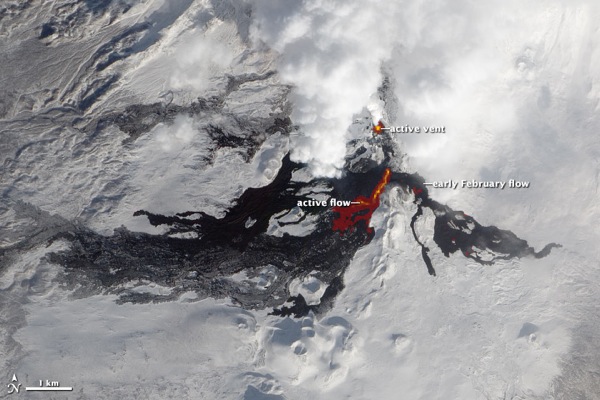Roundup of Global Volcanic Activity:
Etna (Sicily, Italy): Etna had no less than 3 paroxysms (particularly violent brief eruptive episodes) with lava fountains, lava flows and tall ash plumes from the New SE crater within the past 20 hours (so far).
This marks a change from the previous 9-month period characterized by intermittent mild to moderate, but often long-lasting periods of strombolian activity.
Shiveluch (Kamchatka): A small partial collapse of the active lava dome occurred last night at 23h45 (GMT) and produced a relatively small pyroclastic flow, followed by mud flows towards the ravine at the NE flank.
Ann ash plume rose to about 7000 m altitude, VAAC Tokyo reported.
Tolbachik (Kamchatka): The eruption continues with no changes reported by KVERT.
Grozny (Iturup Island): SVERT reported that a gas and ash plume rose to an altitude of about 3000 m on 16 February.
White Island (New Zealand): Elevated continuous tremor interspersed with earthquakes continue.
Popocatépetl (Central Mexico): A phase of increased degassing has been taken place today. This is likely caused by a surge in fresh magma supply.
Elevated activity is also visible on the recent seismogram.
Santa María / Santiaguito (Guatemala): Activity continues to be dominated by moderate explosions. Ash plumes rising up to about 700 m, causing light ash fall in nearby areas. The dome shows a 200 m high degassing plume and there is only relatively weak effusive activity at the lava flows on the dome's flanks
Fuego (Guatemala): The volcano is back to its typical mild, but continuous activity. INSIVUMEH reports 6 weak strombolian explosions with ash plumes rising about 400 m and incandescent bombs ejected to 100-150 m height above the crater.
Turrialba (Costa Rica): An SO2 plume from either Turrialba or Poás volcano is visible on today's satellite data, suggesting increased degassing activity at one of the volcanoes.
__________________________________________________
Nearly three months after Tolbachik began erupting, lava continues to flow from the Kamchatkan volcano. Over time, the lava flows change location and shift across the landscape. In this image, infrared data is superimposed on a natural-color image to highlight active flows.

No comments:
Post a Comment